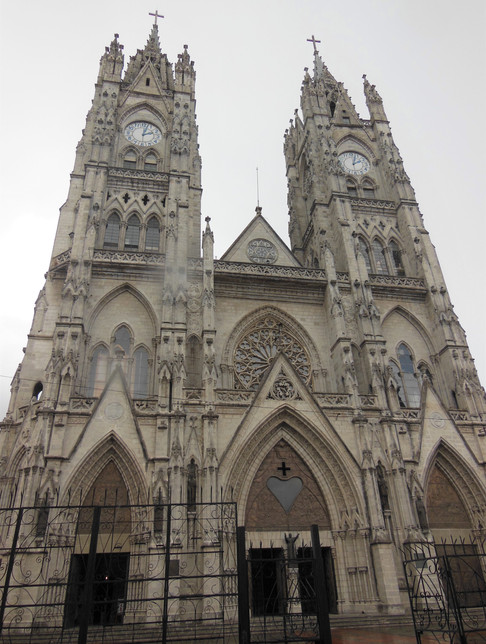The Second Highest Capital in the World: Quito, Ecuador
- Steve

- Sep 27, 2012
- 3 min read
Updated: Apr 21
After spending a day recovering in Cusco, we were on the road again with a short flight from Cusco to Ecuador with planned stops in Quito and Baños de Agua Santa, commonly referred to as Baños. Click on this hyperlinked text to navigate to the Baños blog.
Quito
At an elevation of 9,350 ft (2,850 meters) above sea level, it is the second highest official capital city in the world, after La Paz, Bolivia. Luckily, we had been at high altitude for over a week so we didn't experience any symptoms of altitude sickness. While in Quito, we stayed at Hotel El Crater, an amazing hotel located on the rim of the Pululhua crater. Pullulhua is an inactive volcano which last erupted around 500 BC.

A view looking toward Quito when there were no clouds (sorry for the little bit of window reflection). This amazing hotel was located about 20-30 minutes from downtown Quito.

A view of the volcano caldera from our floor-to-ceiling window. Unlike other volcanoes in Ecuador, Pululahua doesn't appear as a large cone-shaped mountain, but is made up of several lava domes and a large crater about 2.25 miles in diameter.

When you're at an elevation of 9,350 feet, it doesn't take long for clouds to quickly roll in and obscure the view.

Colorful flowers surrounded the property.
Before heading to Quito for the day, we visited La Mitad del Mundo (the middle of the world) a small village 22 miles north of Quito where the Equatorial monument is located.

A French expedition in 1736 identified this site as the location of the equator; it was an amazing feat at the time. This 30-meter-tall monument was constructed between 1979 and 1982 and replaced an older, smaller monument built in 1936 to honor the French expedition.

The painted yellow line divides the 2 hemispheres .... but readings based on modern GPS systems indicate the equator actually lies about 790 feet north of this line. But it was still fun to visit and mug for the photo opportunities.
Quito, formally San Francisco de Quito, is the capital and the largest city of Ecuador. Founded by the Spanish in 1534 on the ruins of an Inca city, Quito proudly possesses one of the most extensive and best-preserved historic centers of Spanish America. The Church and Convent of St. Francis, commonly known as 'El San Francisco', is a 16th-century Roman Catholic complex. Unfortunately, the site was closed during our visit.

A monument to the Virgin Mary is located on top of El Panecillo, a hill at the southern end of the city. It is visible from most of the city of Quito. In 1976, the Spanish artist Agustín de la Herrán Matorras was commissioned to build a 135 ft–tall aluminum monument of a Madonna. This statue is a replica of a sculpture made by Bernardo de Legarda in 1732.

The monument is visible from most of the city of Quito.

Plaza de la Independencia, known as Plaza Grande, is where Quito’s daily life and historic and national symbolism meet. This is the central square of the city and one of the symbols of the executive power of the nation. Its main feature is the monument to the independence heroes of August 10, 1809, a date remembered as the First Cry of Independence of the Royal Audience of Quito from Spanish monarchy.

Also present in the plaza is the Carondelet Palace. The seat of government of the Republic of Ecuador which contains the office and residence of the President.

One of the major sites in the city is Basílica del Voto Nacional, a Roman Catholic church. It is the largest neo-Gothic basilica in the Americas. The steeple and clock towers which rise 377 feet above the church floor are visible from most parts of Quito.
Although the Basilica looks as if it has spent centuries in downtown Quito, construction did not start until July 1892. The French architect, Emilio Tarlier, designed the Basilica after Notre Dame of Paris and the Cathedral of Burgos in Spain.
After walking through the church, we climbed the steps of one clock tower to stand in front of the clock face. Then we moved outside to a viewing platform located between the two towers.
After visiting the clock tower, we followed a long walk across rickety wooden planks perched atop the domed roof of the Basilica but underneath the tiled roof and headed to the steeple.

Then up a short ladder to the outside where another ladder brought us to the top of the steeple with these amazing views.
On a final note, construction on the interior of the church continues. Rumor has it when the building is completed that the end of the world is near.















































Comments